As the summer progresses and the days get brighter and the water gets warmer, Baltic sea trout fishing becomes a nighttime activity.
Fishing for the coastal sea trout in the Baltic area follows a seasonal pattern. During the cold season you can fish for these sea run brown trout all day, and will actually look for days with sun and warmth, which activates the fish. As the spring approaches, the fishing gets worse and worse during the day, while mornings and evenings become the preferred time of day to go sea trout hunting. The same is the case as the autumn approaches and as days grow shorter and the water colder, daytime fishing is an option again.
But during the warmest part of the season from early summer in late May and June and all the way into August and even early September, nighttime is the right time.
Summer sea trout is best caught in the darkness.Sure you hear about people going sea trout fishing among the people swimming in the summer warm ocean and sure a cold summer like the one we're having right now can make daytime fishing an option, but generally coastal fishing is much - like in a lot - better in the dark hours.
This is caused by several things:
Light. The brighter it is the more difficult it if for a trout to hide. OK, big trout have few enemies in the ocean, but cormorants, porpoises and seals take their toll, and the fish grow up with a very deeply rooted fear of being seen. In the uncovered ocean, darkness is a good hiding place.
Temperature. Trout thrive best in cold water and temperatures in the 6-10 degrees C range are generally considered the optimum. As the temperature approaches 12 and 15 degrees it gets hot for a trout and when we're talking 20 deg. C and above we're out of the comfort zone of the fish. Add to that the effect of the sun heating the fish directly, less oxygen in the hot water, potential algae bloom and reduced visibility due to nutrient pollution, and you have several good reasons for the sea trout to stay in the deeper, cooler and darker water during the day, prowling the shallow water at night where it cools down and there is no heat from the sun.
Food. As the summer progresses the quarry reacts to the same conditions as the trout, and many key species will be inactive during the day and active at night. So the hunter follows the prey and hunts in the dark.
Where to go
Theoretically you can night fish anywhere where there are fish in the daytime in other parts of the year, but the best locations are found where deep water cuts close to the shore, often on tips, peninsulas and open, rough and exposed coasts.
Most Danes prefer stone reefs for night fishing. These are mostly found on tips of peninsulas, at points and other places where the coastline extends into the water.
But don't be fooled. Lost of places that seem plain and dull, hide good stone reefs, and local knowledge, guidebooks or some intense work with aerial photos such as Google Maps can reveal some excellent spots where most people won't expect it.
Pattern choices
Foam flies
Foam flies are in many ways ideal for nighttime sea trout fishing. They are eternal floaters, can be tied in almost any color you fancy and are usually both easy to tie and durable. Patterns like Gurglers, the Morrisfoam Diver, various foam head flies like poppers and even my own crazy fly the Plipper will work well as noisy surface flies in the darkness.
Muddlers
My own all time favorite night fishing flies are muddlers. I admit being a muddler man, and have fished a gazillion different muddlers during the Danish nights. Patterns like the classic Muddler Minnow, my own patterns the Small Muddler and the Terrible Muddler have been regular inventory in my fly boxes, but lots of other more or less improvised deer hair flies have been used. One muddler that is very popular here has never been on my tippet: the Cigar, a fly, which is basically an entire body made of black deer hair. Kind of a black Bomber with no hackle. It might work, but I always found it without any charm at all and generally don't like it at all. On the other hand I'd be happy to fish a true Bomber during the Danish night.
Large hackled flies
Any bushy Woolly Bugger type fly will work in the night and beefy Fredes, Bjarkes, Perfect Woollys and Brendas will be good choices. Tie them in large sizes - like a size 2 hook - and don't skimp on materials.
When to go
People who have been out during a Scandinavian summer night know that darkness here is a relative thing. It never really gets dark, and even as this is written - at 10:30 on a cloudy evening in June - it's more than bright enough outside to see clearly. In the height of the summer there's almost always light on the horizon, and darkness only occurs between midnight and maybe 2-3 o'clock after which the sun starts rising again.
We usually try to get out while it's still light, like 9-10 en the evening to check out the location and get the full pleasure of the nightfall. The slow sunset, the wind and water calming, the current picking up is all part of the overture for a good night's fishing.
For people living closer to equator, this is an experience in itself and a vast difference from the sun setting at 6 and day yielding to a pitch dark night, which then changes to day in a short time around 6 the next morning.
Once it darkens you are often called to the water by fish jumping, splashing or moving in the surface.
Let the games begin!
What to use
Nighttime sea trout fishing isn't very different from daytime fishing when it comes to gear. You can simply just continue using whatever you use during the day.
But you can also choose to adapt your setup a bit. Personally I like to exchange the popular shooting head setup with a traditional floating WF line and I also like to use a shorter and heavier leader and tippet. The simple reason for this is ease of casting and better presentation when casting in the dark. The lack of light forces you to feel more than see what you are doing, and the WF line with a less delicate leader might lead to slightly shorter casts, but also make each cast better and give you better presentations. The setup requires less technique and precision, and will typically be more forgiving and still deliver the fly nicely.
You can use the usual shooting head and shooting line, but the advantages of this setup - distance and effortless casting for many hours - aren't called for to the same extent at night. It's more important to be able to cast short and precise casts and have the fly fish as soon as it hits the water.
Flies
Flies for nighttime fishing typically have one or several of these traits: floating, black, bushy. You can also translate bushy into voluminous, because the aim is to have a fly that moves water - "makes noise" so to say.
You typically want flies that fish high in the water or even in the surface. The color is more tradition than anything else. Since most fish will see the flies from below, the color isn't really important since it will be seen in profile. Personally I like to fish bright yellow and orange flies, and even white flies have found their way on my tippet in the dark.
Flies like foam flies, muddlers and bushy hackle flies in the Woolly Bugger style are popular choices, but in a tight spot you can fish most coastal flies. If you're a Pink Pig fan, use that. A meaty zonker? That will work. More like an Omoe Brush or Grey Frede fisher? No worries, they can be used at night too. But choose the generously dressed flies on larger hooks.
How to fish
Current is often the key to successful summertime fishing. The current brings in colder water and stirs up the water, bringing out the food items from sea weed and rocks. This brings the sea trout on their fins, and sheltered by the dark they will often hunt very close to the shore and be visible in the surface revealed by rings, wakes and even obvious splashes.
So there's essentially two approaches:
1) targeting seen fish with few, precise casts, much like what you'd do to rising fish in a stream. This is a pretty obvious way of fishing, since you see fish, see where they are hunting, maybe even see the direction they are moving and place your cast based on that.
2) fishing systematically over structures often utilizing the current - also much like a stream. You cast down and across, even though across makes little sense when casting in the ocean. Anyhow, the idea is to swing the fly in the current and make it look like a small fish or other quarry floating and moving in the current, often fighting the moving water.
Light
So fishing at night isn't necessarily fishing in total darkness. It can be dark, though, and unless your night vision is really good you will need a bit of light for tying on flies and maybe for navigating when you wade - not least because rocky shores and reefs are often preferable for night fishing.
Generally it's better to keep artificial light low or even shut off because the longer you stay in the unlit darkness the more your eyes adapt to the darkness and the less you need the light.
Don't forget to have a good time
When being outdoors during the summer nights, it's logical to raise the game a bit and enjoy the outdoors. Don't forget to bring a small portable barbeque or make a fire and let it burn out. Bring some meat or sausages and bread plus assorted condiments and you can have yourself a meal, which beats almost any indoors meal you have had.
Great weather, the sound of the water, fish moving in and a full stomach is a very good combination. Freshly brewed coffee isn't bad either, and the difference between water that just passed through ground beans compared to coffee from a thermos is motivation enough to bring a small stove, a kettle and the tools to brew fresh mocca. And don't even think of instant coffee! If you ever offer me instant on a night fishing trip - or any trip for that matter - you are off my friends list in a heartbeat!
If you plan of staying out during the night, an mattress is a good idea, and even a thin sleeping bag can be nice. It might feel like Sahara when you are hiking to your fishing spot, but once the sun disappears and heat starts radiating out into the open sky, it will become way colder than you imagine, and fleece, jackets and a blanket or a sleeping bag will be just what you want.
And a couple of hours sleep on the beach if the action dies out is definitely worth considering. Waking up to the first light and the promise of a full morning of fishing is simply the best, and much easier than setting the alarm clock to half past beep in the morning and trying to get out of bed to go fishing before the sun rises.
Finding locations
Lots of guidebooks list locations that are suitable for night fishing for sea trout, but a little map studying can actually help you find your own, and resources like aerial photos or detailed satellite photos can give you the tools needed to spot your own.
|
|
|
|
|
|
|
The photos you see here are from Google Maps, all shown to the same scale and all indicating interesting structures that might be worth spending a few dark hours on.
You are generally looking for stone structures on the edge of deeper water and preferably on points - even though this isn't a firm demand. You can find excellent night fishing on open coasts. You just need places where the current will move cooler water close to the shore. Exchanging the water that has been heated by the sun during the day. The colder water induces activity in the quarry species and when that happens the sea trout follows.
- Log in to post comments

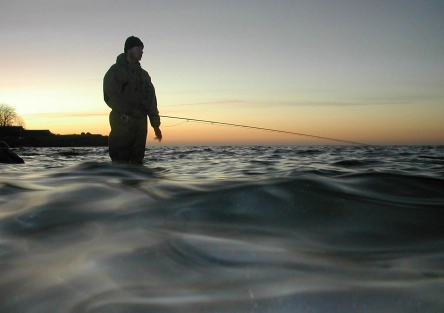













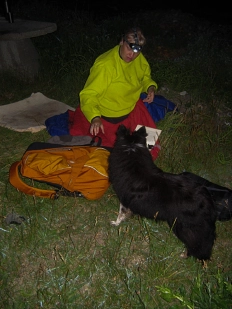

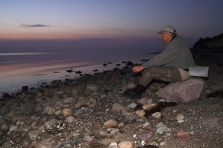

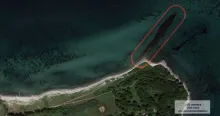


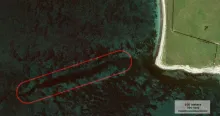
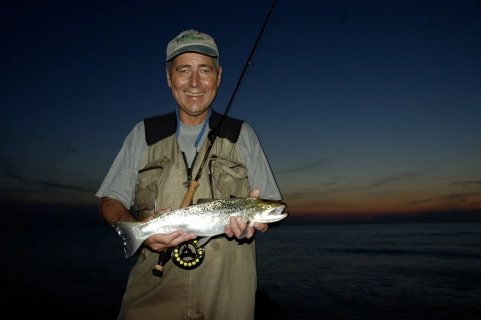








Phil,
We can safe
Phil,
We can safely release the fish here. We have porpoises, but none that will go so close that they take newly released fish.
Martin
Here in Florida U.S.
Here in Florida U.S.A. we catch a lot of sea trout at night under dock lights. Our trout are of a different genus and species but pose similar challenges. I'll bet we even use similar patterns! We find it difficult to safely release trout due to ever-present porpoises. Have you any such difficulties?
fishing at night
Fish species with the largest eyes in relation to their body mass are most likely to feed at night.
porpoise protection
Porpoises are impossible to avoid, and released sea trout released in their presence suffer a 100% mortality rate. I have quite a few old, rusty fly hooks [NOT stainless steel]. in size 12 or smaller. Before I release a trout I pin one of these small, rusty hooks (no line attached) lightly in the corner of the trout's mouth. Porpoises have a very sensitive sonar system. I have watched them veer away from sea trout with a hook in its mouth.